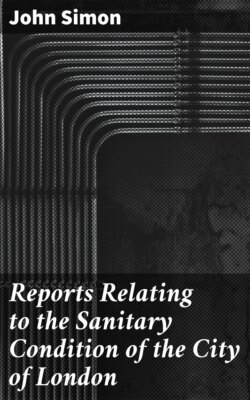Reports Relating to the Sanitary Condition of the City of London

Реклама. ООО «ЛитРес», ИНН: 7719571260.
Оглавление
John Simon. Reports Relating to the Sanitary Condition of the City of London
Reports Relating to the Sanitary Condition of the City of London
Table of Contents
PREFACE
FIRST ANNUAL REPORT
HOUSE-DRAINAGE
WATER-SUPPLY
OFFENSIVE AND INJURIOUS TRADES
INTRAMURAL BURIAL
HOUSES PERMANENTLY UNFIT FOR HABITATION
SOCIAL CONDITION OF THE POOR
SUGGESTIONS FOR SANITARY ORGANISATION IN THE CITY
FURTHER REMARKS ON WATER-SUPPLY
SECOND ANNUAL REPORT
I. Mortality of the City of London
II. The Causes and the Prevention of Endemic Disease
Sub-soil Drainage, House-Drainage, and Sewerage
Water-Supply
Offensive or injurious Trades
Burial-Grounds
Habitations and Social Condition of the Poor
III. Suggested Alterations in the Act of Parliament
THIRD ANNUAL REPORT
FOURTH ANNUAL REPORT
FIFTH ANNUAL REPORT
APPENDIX OF TABLES. ILLUSTRATING THE. SANITARY CONDITION OF THE CITY OF LONDON
No. I. Area and Population of the several Districts and Sub-districts of the City of London
No. II.—Quinquennial Synopsis of City Mortality, with Death-rates calculated per Thousand on the Population of 1851
NOTE TO TABLE No. II
No. III.—First Annual Enumeration of Deaths, relating to the Fifty-two Weeks dating from October 1st, 1848, to September 29th, 1849
No. IV.—Second Annual Enumeration of Deaths, relating to the Fifty-two Weeks dating from September 30th, 1849, to September 28th, 1850
No. V.—Third Annual Enumeration of Deaths, relating to the Fifty-two Weeks dating from September 29th, 1850, to September 27th, 1851
No. VI.—Fourth Annual Enumeration of Deaths, relating to the Fifty-two Weeks dating from September 28th, 1851, to September 25th, 1852
No. VII.—Fifth Annual Enumeration of Deaths, relating to the Fifty-two Weeks dating from September 26th, 1852, to September 24th, 1853
No. VIII.—Quinquennial Mortality, classified by Age, first for the entire City, next for the three Unions severally
No. IX.—Number of Deaths occasioned, during the last Five Years, by certain Acute Diseases, chiefly Epidemic, Infectious, and Endemic
No. X.—Comparative Mortality in different seasons of the Year; namely, in the Autumn Quarters (Oct., Nov., Dec.) in the Winter Quarters (Jan., Feb., March,) in the Spring Quarters (April, May, June) and in the Summer Quarters (July, Aug., Sept.) of the Five Years from Michaelmas, 1848, to Michaelmas, 1853
No. XI.—Comparative Mortality in Different Seasons of the Year
No. XII.—Comparative Mortality in Different Seasons of the Year
No. XIII.—Comparative Mortality in Different Seasons of the Year
No. XIV.—Comparative Mortality in Different Seasons of the Year
ON THE PRESENT. BURIAL-PLACES OF THE CITY
INTRODUCTORY REPORT. SUGGESTING THE. OUTLINE OF A SCHEME. FOR. EXTRAMURAL INTERMENT
STANDARD BOOKS. PUBLISHED BY. JOHN W. PARKER & SON, LONDON
Отрывок из книги
John Simon
Published by Good Press, 2021
.....
From these comparative tables it will be observed, that the high mortality of the population does not affect the entire City equally; that, in some of its portions, the rate of death approaches the minimum standard much more nearly than in others; that in those districts where the general rate is best, the temporary aggravation from epidemic causes has likewise been least; and that our aggregate City rate, either for ordinary times or for a period of epidemic disease, is compounded from the joint result of several very different proportions. Reference to the Registrar-General’s tables will enable any one to see that the ordinary rate of mortality for the West London Union is a fourth higher than the rate for the City of London Union, while the rate for the East London Union bears a still higher proportion; and these very different rates are, as it were, merged in the one aggregate rate, struck for the whole City, as comprising the three unions referred to. It will be obvious, therefore, that many parts of the City are much healthier than this aggregate rate would signify, while others are much unhealthier. In regard of last year, for instance, the aggregate rate of mortality was (as I have stated) 30 per thousand of the general population of the City: but if this rate be analysed by examination of the sub-district mortality, it will be seen that in one sub-district the rate of death stood nearly as low as 20; that in another sub-district of the same union it rose to 36, and in a third sub-district (of another union) to within a small fraction of 40.[15]
[15] On account of changes of population shown by the subsequent Census, these figures would require correction. The death-rates per thousand in the several sub-districts were probably about as follows, viz.:—
.....